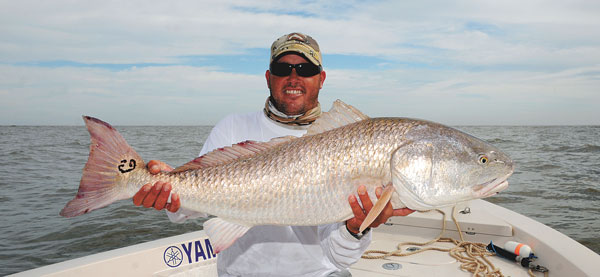
For a real chance at a state-record fish, target a handful of species in a handful of areas.
As long as there have been anglers, there have been those who are never satisfied with anything other than the biggest and meanest things that swim.
Men and women spend hours, days and even years in pursuit of monster fish. Some have even been known to become obsessed with the pursuit of these leviathans of the deep.
Fortunately, anglers in South Carolina don’t have to travel far to find these monsters. If anything, narrowing down which species to pursue is the greater challenge.
And while there are many fine species offshore that will stress anyone’s fishing skills, most efforts on behalf of big fish are concentrated on inshore saltwater areas or in freshwater. A five species stand out as far as their largest examples being available to the largest number of fishermen: tarpon, shark, redfish, catfish and striped bass.
So take these tips from fishermen who are intimately familiar with these fish, do your homework and go catch a state record.
Tarpon
While South Carolina isn’t really known as a hot spot, many silver kings find their way to our coast each summer and hang around through early fall.
J.R. Waits of Fish Call Charters out of the Isle of Palms is one of the most-experienced tarpon guides along the South Carolina coast. His customers regularly catch them whenever they’re around, and Waits appreciates how difficult it is to put one in the boat — especially a huge one.
“Tarpon are by far my favorite fish to catch.” Waits said. “They pose such a challenge — getting the bite and then with all of their acrobatics — getting one landed is quite an accomplishment.”
Waits has landed many fish in the 60- to 80-pound class and a few that topped the magic 100-pound mark. While tarpon can reach twice that size in other areas, in South Carolina waters, a 100-pound tarpon is a trophy for anyone. Most fishermen who target tarpon use live mullet — the bigger the better. Waits said the best fishing coincides with the mullet migration, which usually occurs in earnest in mid- to late September.
“When the mullet are running, the fishing is unbelievable,” he said. “We start catching tarpon in late June, and they are here until early October, but for the best fishing, the last three weeks of September, cannot be beat. From Bulls Bay north to McClellanville the fish are here in abundance.”
The way Waits targets tarpon is straight-forward and not unlike fishing for other species in Bulls Bay. Find a sandbar with a good drop-off, toss a lively fresh mullet out behind the boat and wait for the action.
Tarpon are indeed some of the most-exciting fish in the ocean that can be caught on rod and reel. Their bites are sudden and furious; once a tarpon inhales your mullet, it will immediately jump.
“Once he feels the hook, the real acrobatics begin.” Waits said, describing fish that often clear the surface by more than 10 feet and peel line off a reel faster than you can imagine.
Tarpon are strong fish; there’s no denying that, but if you really want something to pull on your line and test your strength and endurance, then after you land your tarpon, change bait and go after the predators.
Sharks
According to Brian Frasier, head of shark research for the S.C. Department of Natural Resources, sixteen species of sharks are listed in the state record book. While most are rather benign, some offer a real challenge for the angler.
“The target species for the angler would be the blacktip, lemon, tiger, bull and, to a lesser extent the hammerhead.” Frasier said.
Lemon and blacktip sharks are among the more abundant of the larger species, and they offer a true test of angler and equipment.
Fishing for shark is not all that complicated. You need heavy gear and smelly bait.
“I like to use big mullet and menhaden,” Waits said, “These are real greasy fish, and they make excellent bait.”
Shark like the smell of cut bait. Simply load a 10/0 circle hook with a hunk of fresh cut bait and cast it in deep pools on low tide or around sandbars on a falling tide and hang on.
Sharks don’t play around with their food. Once hooked, most sharks will peel off 100 yards of line immediately; maintaining control of the fish is touch and go. This is where the circle hooks earn their keep, imbedding in the corner of the fish’s mouth, rarely to be dislodged.
It’s not uncommon to have to leave your anchor and chase after a big shark to keep from having your reel spooled — and in just seconds.
Sharks are seldom kept by fishermen, although blacktips provide some very fine table fare. Make sure a fish meets size minimums and is dead before bringing it onboard; they are dangerous fish when inside a boat.
Whether you prefer blacktip, lemon — or get lucky and get into a tiger or bull shark — these strong monsters are worth the pursuit and battle. They will test you and your gear, and they are readily accessible.
Redfish
Redfish are the favorite inshore species of many, many South Carolina fishermen, because they have few equals when it comes to getting your blood pumping, and catching them isn’t difficult.
Now, catching a monster bull redfish is another story. You target them with the same tackle and technique as tarpon, but in most cases, in different locations, with Charleston Harbor being a peak destination — but not the only one. The state record fish, which weighed 75 pounds, was caught in 1965 out of Murrells Inlet.
Concentrate on the jetties and rocky outcroppings in the harbor for the big bull reds. Mullet and menhaden are the baits of choice, with a 10-inch mullet an ideal specimen. A 10/0 circle hook threaded through the nostrils of a mullet allows it to swim freely and lively. The rest of the rig looks like this: 50-pound braid, topped with a 3- or 4-ounce weight slid on above a barrel swivel or tied to a 3-way swivel that will allow the weight to be popped off if hung up in the rocks. The leader should three to four feet of 30-pound fluorocarbon.
Because all bull reds must be released, get them to the boat, take a quick photo, measure or weigh them and get them back in the water as soon as possible.
But if saltwater isn’t your cup of tea, South Carolina has several freshwater monsters swimming in its waters.
Catfish
South Carolina has long had a reputation for producing giant catfish, and there is no better place to go than Santee Cooper to find the real giants — if you’re interested in tackling a fish that will feel like a Buick on the end of your line.
Gene and Clayton Crawford of Crawford Fishing Tours guide for monster catfish out of Black’s Camp on Lake Moultrie. Their approach to targeting big blue and flathead catfish is straight-forward.
Drop a bait with a strong odor to a likely spot on the bottom and wait. Big fish like big baits, and the array of baits is as broad as those who fish for them: herring, shiners, bream, shad, white perch.
“If the fish are here, we will get some action in the first five minutes,” Clayton Crawford said. “If not, we move to where they are.”
Too many fishermen spend hours waiting for fish that just aren’t in their area. Finding fish is much more important than the kind of bait you’re using.
The early spring, with the waters just beginning to warm, is the best time to catch the true monsters of Santee. These fish are ready after a long, slow winter to start feeding and getting ready for spawn. They need to eat; big fish eat a lot, and they eat big meals. One of the more common mistakes when fishing for big catfish, is using too small a bait. Many anglers fish 3/0 hooks and small chunks of liver and wonder why they catch fish only in the ten to fifteen pound range. If you really want to catch a monster use monster bait. 8/0 or bigger circle hooks topped with some of the largest bait you can get your hands on. Whole shad, menhaden, Mullet, or even bream make great bait. Put a large bait in front of a monster catfish and you will have your hands full.
The gear is similar to most, although many guides in Santee prefer 80# braid due to the amount of trash in the water. Its strong, no stretch and will land the biggest things out there. Big bait casting reels, and spinning reels dominate the landscape and for my money nothing beats a seven foot Ugly Stick loaded with either a PENN CRQ 7000 spinning reels or Abu Garcia 6500 bait casting reels for monster catfish.
Some anglers prefer the fast water of the diversion canal or the tailrace waters below the Moultrie dam, and these areas do produce large fish annually. But too consistently catch fish over 50 pounds you have to go where these fish congregate. Stump holes, deep pools near shallow water, and in near feeder creeks are all likely places.
When it comes to freshwater, catfish are my personal favorite. I never know when that rod bends if the fish on the other end is two pounds, ten pounds or one hundred pounds and that is what draws me back time after time. But if Catfish aren’t something that gets you excited to go out on a cool morning; then the other monster of our lakes and rivers surely will.
Striped Bass
The state fish of South Carolina is also one of her most sought-after. The strength of these fish is really something to behold. Hooking a 7-pound striped bass will to the uninitiated feel like they have a thirty 30-pound grouper on the other end. These fish are strong, and their fight is perhaps the best of all freshwater species we have in our state.
While Santee Cooper is where land-locked striped bass fishing first took place; if real monsters are what you’re after, other impoundments may make a better choice.
Lake Thurmond, Lake Hartwell and Lake Russell on the Savannah River system all produce fish over 40 pounds annually, with an occasional 50-pound specimen being caught. In fact, the state record has moved through all three lakes. The current record of 63 pounds came from Lake Russell in 2009, replacing the previous record of 59 pounds, eight ounces from Lake Hartwell. Both fish were caught by the same angler, Terry McConnell.
Typically, monster striped bass are caught in the cooler months. Preferring cooler water, striped bass become more active as the temperature drops. Most of my large striped bass have come in January and February.
Blueblack herring and large shiners are best, free-lined over humps or in creek channels. As the water cools, baitfish move into creeks in search of warmer water, and the striped bass are right behind.
Occasionally, large schools of stripers can be seen ripping through a school of baitfish. Anglers rush to the schools and cast spoons, jigs and topwater lures into the schools, and hook-ups are fairly common. For larger fish, use a very heavy spoon, like a 2-ounce Hopkins, and cast into the school, letting it sink as fast as possible. Most of the larger fish are at the bottom of the feeding frenzy picking up the bait that falls through the school.
By allowing your heavy spoon to fall through the school, you are more likely to pick up larger fish. Most of my hook-ups occur before I ever move my spoon, rather, as it’s falling through the school, a fish will hit, and the fight is on.
If you really want some action, use a double-rig with a bucktail and a spoon tied onto the end of a 3-way swivel. It’s very common to hook two fish at once on this rig. Just make sure one of the leader lines is longer than the other.
While you may not think of South Carolina as a destination for monster fish, we certainly have our share of trophies roaming our waters. While many may not top out in the hundreds of pounds, all of these are certainly worthy opponents. Your list may contain more or different species. A quick glance through the record book will show a host of other worthy species that can be added. But for accessibility, and availability these five are certainly some of the finest species all anglers can and should give a try in our waters.

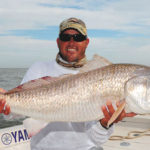
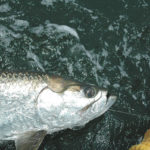
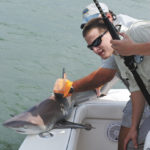
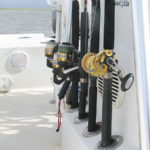
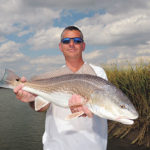
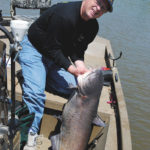
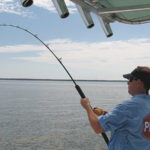
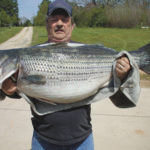



Be the first to comment